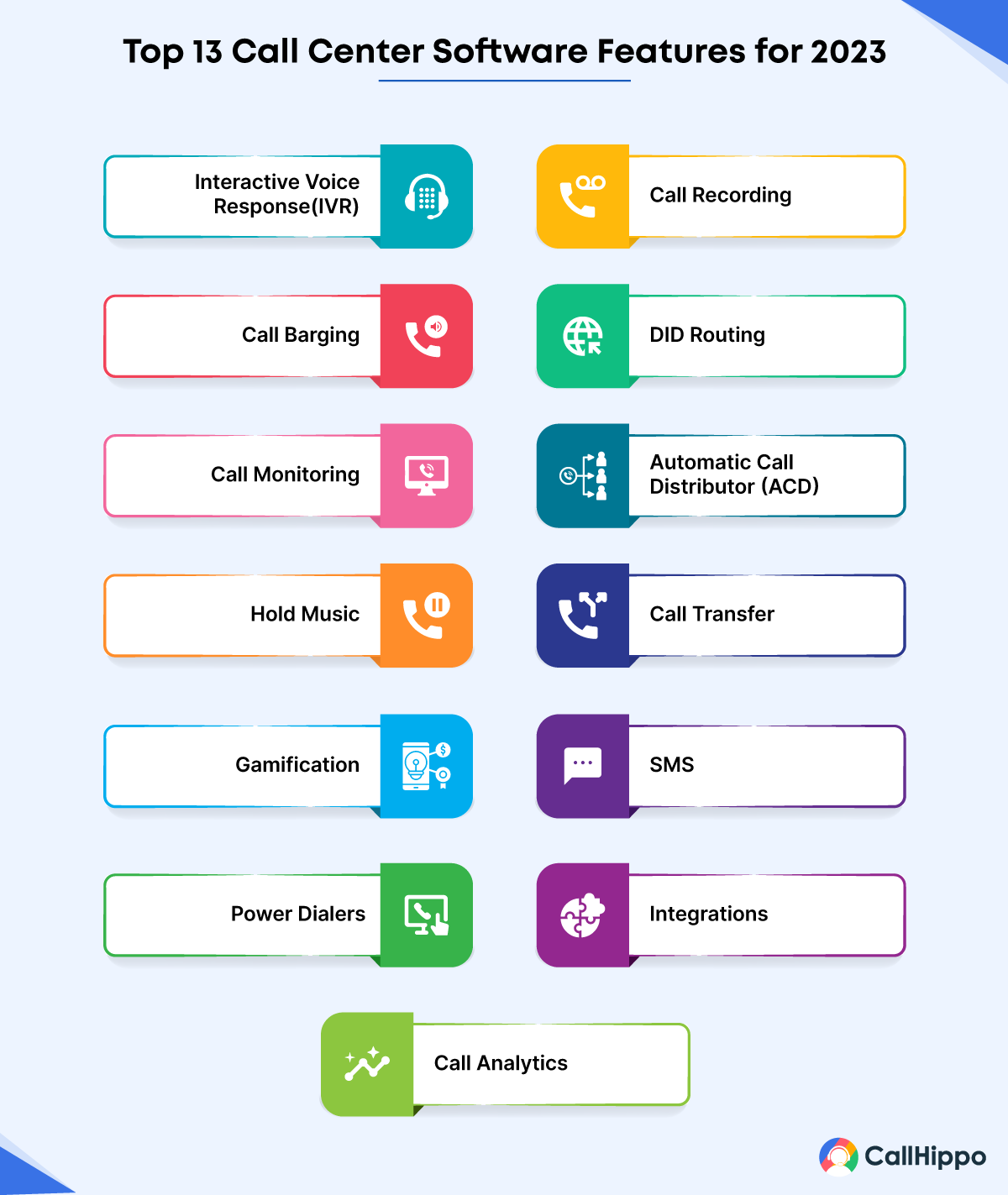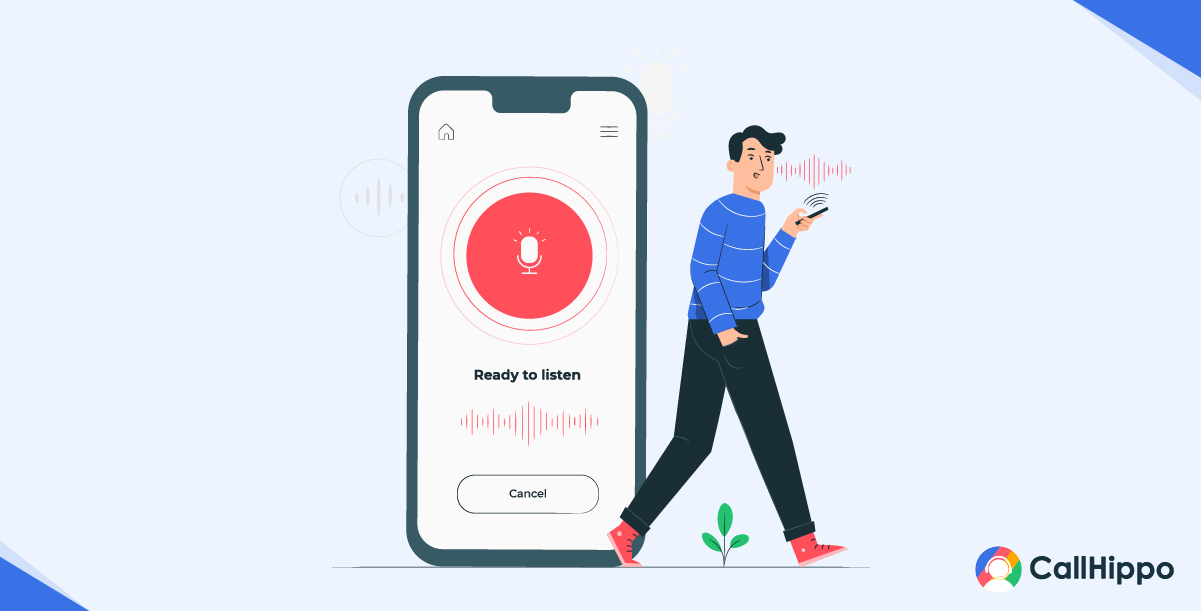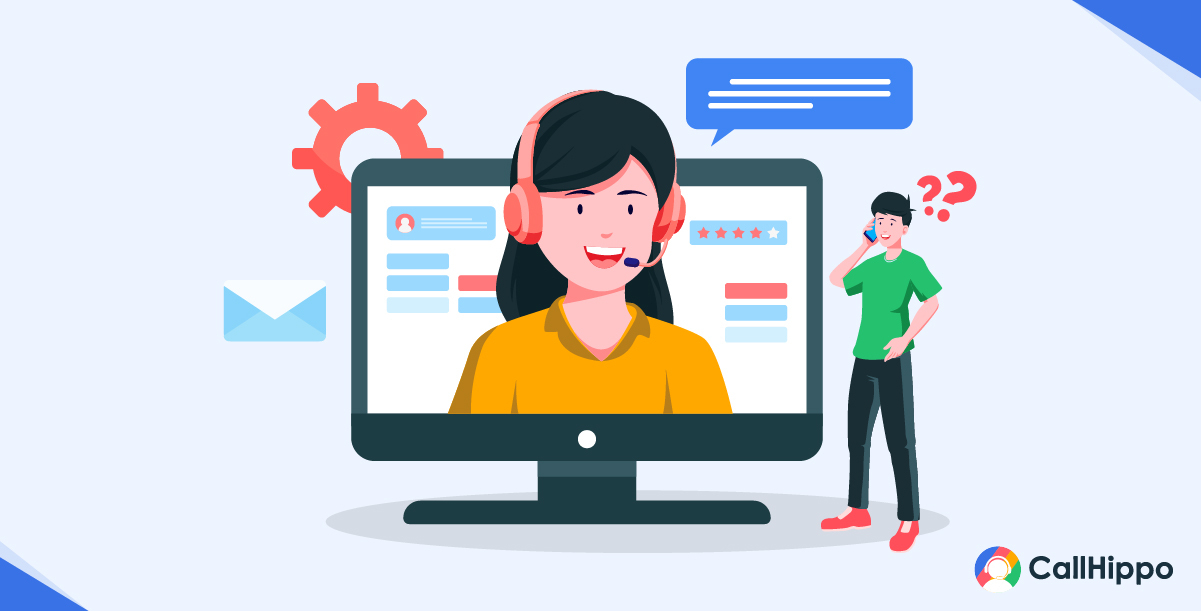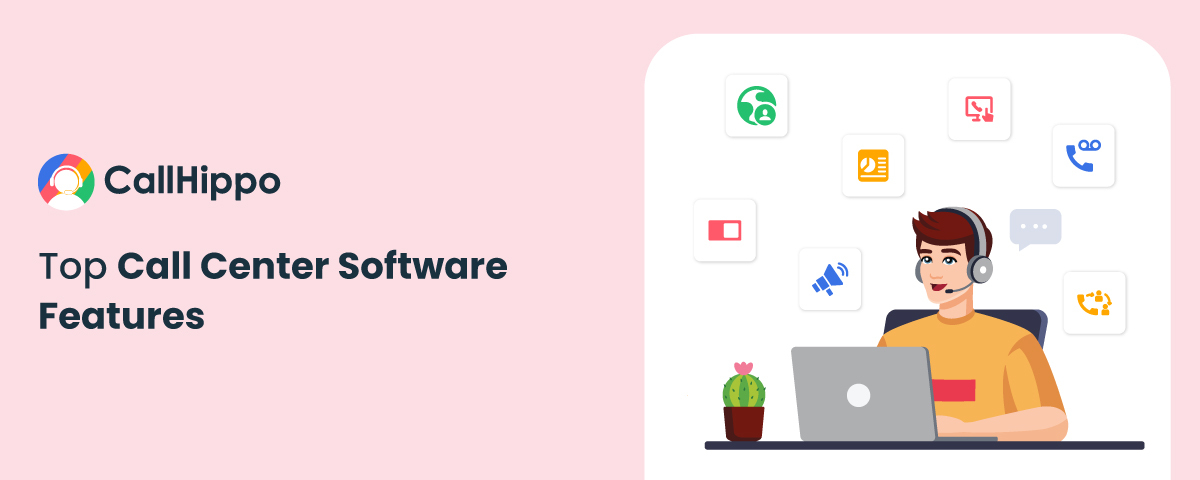In today’s fast-paced world, call center software plays a crucial role in providing excellent customer service and boosting business success. According to research, in 2022, global contact center software was worth $28.09 billion, and it’s expected to grow at an impressive annual rate of 23.9% from 2023 to 2030.
Whether you’re a small startup or a big corporation, understanding these essential call center features is like having a master key to unlock your call center’s full potential. In this blog, we will take a closer look at the top 13 call center software features that you must consider when choosing your next call center solution. Let’s dig deep!

"Pay attention to call center system features to leverage a competitive advantage. Verify that the program can expand with your company and that there is adequate customer service available in case you have any problems. Choosing the appropriate call center software is essential for increasing output and maintaining client satisfaction."
13+2 Call Center Software Features
There is a wide range of call center software options available, each with a unique purpose in mind. Certain ones are more appropriate for inbound call centers, while others are designed for outbound call centers. These solutions meet the unique requirements of every kind of call center by providing a wide range of features and functionalities.
They enable organizations to improve their customer service and communication skills, whether it’s responding to customer questions or proactively contacting clients. For successful customer calls, software selection must be in line with the unique objectives and operations of the call center. Some of the most common call center software features include:

1. Interactive Voice Response(IVR)
IVR, an electronic voice menu, empowers callers to choose the right agent for their specific needs. It is essential to ensure that the IVR system is designed for simplicity and intuitiveness for customers.
Transforming the customer experience, this call center software feature serves as a valuable tool for businesses. It enables customers to interact with an automated system before connecting with the support team. While some customers initially prefer human interaction, the IVR system assists in issue resolution and the collection of vital information for improved service.
This technology efficiently manages call volumes by all outbound calls and gathering relevant customer data. When customers finally reach a human representative, all necessary information is readily available, eliminating the need for repetitive explanations.
2. Call Recording

“This conversation may be recorded for training purposes,” the pre-call notice that you’re familiar with is not a coincidence. Recording phone calls has become commonplace and has many advantages. Call recording is the process of recording and storing phone calls as digital files that can be kept locally or on the cloud.
Call center software typically offers two types of recording: automatic and on-demand. Users can manually start call recording with just a button push when using on-demand recording. Conversely, automatic call recording saves users’ trouble by initiating recording as soon as the call starts. Your team can benefit from extensive training and skill development thanks to these recorded calls.
3. Call Barging
One of the most prominent call center phone systems features is call barging. This feature gives managers or supervisors the ability to actively participate in ongoing live conversations between agents and customers. It provides a way to improve the quality of customer calls and make agent coaching easier in a contact center setting.
Conceptually, call barging is similar to two well-known features: call monitoring and call whispering. Call monitoring enables in-the-moment call observation and later recording for future use.
On the other hand, call whispering allows supervisors to subtly mentor agents without the customers knowing. Call barging is special because it can turn a supervisor-agent-customer conversation into a conference call with all three parties.
4. DID Routing
Direct inward dialing (DID) is a phone system feature that quickly connects incoming calls to specific users or voicemail, bypassing automated menus. DID can be accessed by businesses by renting phone numbers from service providers and assigning them to users, queues, or ring groups.
DID is available for both cloud-based and traditional landline PBX systems, with the setup process different depending on whether your phone system is VoIP or PSTN-based.
A DID number is a direct business phone line that does not use IVR menus. Local and toll-free numbers are assigned to landline PBXs based on their location. In contrast, a cloud-based PBX (VoIP or UCaaS) allows you to obtain and assign local, toll-free, or vanity numbers from any location for more flexible communication.
5. Call Monitoring

Call monitoring within most call center software offers various tools that go beyond simply listening to agent-customer conversations. These tools include “call whisper” for discreetly coaching agents during calls, “call barging” to allow managers to join calls and assist, and “call takeover” for others to speak to the customer. These features enable supervisors to better assess agent training needs and evaluate the quality of customer service.
In essence, this feature allows for real-time listening to agent-customer interactions, facilitating training and assessment. It includes “whisper coaching” to provide agents with immediate feedback without customers overhearing, “call barging” for managerial support, and “call evaluation” to rate agent performance based on specific criteria. Ultimately, these tools enhance agent skills and the overall quality of customer service.
6. Post-Call Surveys
Post-call surveys serve as an invaluable call center software feature. It lets you gather customer feedback and insights by sending automated surveys via email or SMS to clients immediately after their call ends.
The surveys typically include rating scale questions about agent performance, issue resolution, likelihood to recommend, and overall satisfaction. Some systems even allow customizing open-ended questions specific to the interaction.
Post-call surveys provide a voice to the customer while the experience is still fresh in their minds. The candid feedback helps call center managers identify strengths, uncover weaknesses, and highlight opportunities to improve customer satisfaction.
By tracking survey response trends over time, contact centers can measure the impact of changes and how well agents adapt to new initiatives. This level of actionable data is invaluable for optimizing processes.
7. Hold Music
Hold music is the music that plays while you are on hold during a phone call. Its main purpose is to avoid awkward silences and make callers’ waiting times more pleasant. Depending on the company’s preferences, it can be of various genres, such as pop, classical, or jazz. Some companies even use custom tracks that represent their brand.
Aside from music, hold time can be used to communicate important information to customers. It may include announcements, promotions, or general information about a product or service that is beneficial to both the company and the caller. So, the hold music contact center feature is more than just filling a void; it’s a tool for improving the customer experience and reinforcing a brand’s identity.
8. Call Transfer
Call transfer is a phone system feature that allows you to transfer an ongoing call from one person to another. The two types of transfers are warm and cold. To ensure a smooth transition, the person initiating the transfer first discusses the context of the call with the recipient before forwarding it. This is referred to as a warm transfer.
This is useful when the recipient requires some background information. A cold transfer, on the other hand, occurs when the call is transferred to the new recipient without prior notice. It’s the same as abruptly advancing the call. Warm or cold transfers should be chosen depending on the circumstances and the need for context sharing during the call handoff.
You May Also Read : Difference between: Call Forwarding Vs Call Transfer Vs Call Diverting
9. Gamification
Gamification is a dynamic approach to workforce management that involves introducing elements of gaming culture into the workplace in order to boost performance and inspire employee enthusiasm.
This idea is especially useful in industries where routine tasks can become monotonous, such as call centers. It presents the appeal of establishing and accomplishing goals, much like quests in video games, and cultivates a welcoming, competitive environment. Employees are able to monitor their performance and receive a clear assessment of their progress thanks to real-time performance metrics that are converted into scores, levels, and leaderboards.
Top performers are recognized and may receive virtual badges or tangible rewards in this gamified environment, further motivating their dedication. Gamification is important for increasing productivity, service quality, and overall job satisfaction, in addition to simply making work more enjoyable.
10. SMS

SMS, or texting, is a handy way for your customers to talk to your company. It’s great for people who like sending texts, making it easier for them to get in touch with your business. When your customers can send or get replies through texts, it makes them more likely to contact you. This is good for keeping customers happy.
Also, SMS lets your support team talk to many customers at once using text. That means your team can answer questions quickly and help more customers. This makes your customer service faster and better, making customers even happier. It also helps your business work more efficiently. So, it’s a win for your customers and your company.
11. Virtual Queuing
Long hold times can quickly frustrate customers and cause them to abandon the queue. Virtual queuing eliminates frustrations through advanced call routing algorithms. This feature allows callers to hang up after entering a queue and receive a callback when an agent becomes available.
Virtual queuing maximizes customer experience by freeing up their time instead of keeping them on hold. It also reduces abandonment rates compared to traditional queues. Contact centers benefit from lower idle time between calls, helping agents achieve more efficient utilization.
12. Integrations
The majority of call center phone platforms are now equipped with a variety of business tools and applications. These platforms connect your call center data to other vital tools like calendars, workforce management programs, and CRM (Customer Relationship Management) platforms through third-party software interfaces. One of the best examples of this is the combination of Zoho CRM and Salesforce, two CRM platforms.
The streamlined operations are greatly aided by these interconnections. They make it easier for call center representatives to monitor and handle these encounters throughout the whole sales pipeline by facilitating the smooth flow of information about incoming callers. Consequently, this improves the caliber of customer service by giving agents access to useful information and enabling them to offer tailored assistance.
13. Call Analytics
Every day, call centers collect massive amounts of data, providing valuable insights that may be used to improve their performance. It is critical to monitor specific call center metrics in order to determine their operational efficiency. The average wait time reveals how long customers have to wait for assistance, whereas first-call resolution evaluates the capacity to resolve issues in a single contact, demonstrating service efficiency.
The call abandonment rate reflects how frequently clients hang up before their issues are resolved, which may indicate a problem with the service. The ultimate goal is customer satisfaction, and measuring it guarantees that clients are satisfied with the service they receive. Analytics tools are required to make the most of this data. These technologies can analyze metrics, discover trends, evaluate agent productivity, and find problem areas.
Bonus Features
14. Automatic Call Distributor (ACD)
ACD functions similarly to a smartphone’s call manager. It is intended to ensure that when you call a company, your call is routed to the appropriate person or department without delay. ACD works by taking into account a variety of factors, including who you are when you call, and the type of assistance you require.
You won’t have to figure out which number to dial or wait on hold for long. Consider ACD to be a helpful guide for your calls. It quickly routes your call to the appropriate department, ensuring that you receive the assistance you require. If the goal is to ensure that everyone in the company contributes equally, ACD can route the next call to the agent who hasn’t already.
15. Power Dialers
An hour of repetitive labor can be easily accrued by outgoing call center agents who dial thousands of numbers every week, even though a single call might not take much time. Thankfully, power dialers—also referred to as auto-dialers—offer a way around this problem. By automating the process of dialing phone numbers from a predetermined list, these platforms save a significant amount of time and money on manpower.
Power dialers frequently have extra features that boost productivity. One such feature is the preview dialer, which helps agents better prepare for calls by showing them the next customer record. Another useful feature is the predictive dialer, which can dial numerous numbers at the same time and only connect a call when someone answers, greatly expediting the calling procedure.
Wrapping Up
In order to meet the needs of the digitized globe, the contact center software industry is rapidly changing. Call centers are now critical to providing excellent customer service and promoting overall business success. The software, which offers a variety of features aimed at streamlining operations and improving the customer experience, is at the heart of these call centers’ efficiency.
Furthermore, the incorporation of gamification, SMS functionalities, and sophisticated analytics tools allows contact centers to remain competitive and customer-focused in this rapidly changing business environment. Connect with our experts and learn more about contact center software features today!
FAQs
1. What are the Best Call Center Phone Systems?
Identifying the optimal call center phone system is pivotal for efficient customer support. Leading options primarily include CallHippo and Five9, recognized for their adaptability and scalability, and on-premises solutions like Avaya, offering robust administrative control.
Alternatively, businesses can explore Aircall for its intuitive interface or Twilio for its versatile integration capabilities. Assessing your specific needs and budget is vital in determining the most suitable solution for your call center.
2. Why is call recording important for call centers?
It is impossible to overestimate the importance of call recording in contact centers. First off, it is essential to quality control because it makes supervisor oversight and agent performance evaluation possible, resulting in top-notch customer service.
Second, call recordings are a crucial piece of evidence in conflict management and dispute resolution. Call recordings also help with agent coaching and training, which improves their abilities and general operational effectiveness.
3. Are these software features suitable for all types of call centers?
While the previously mentioned software features are beneficial to different call centers, their suitability depends on particular needs. Systems hosted in the cloud, such as Five9, are adaptable and suitable for small to large businesses. Large businesses that need strict control might be better served by on-premises solutions like Avaya.

Subscribe to our newsletter & never miss our latest news and promotions.








